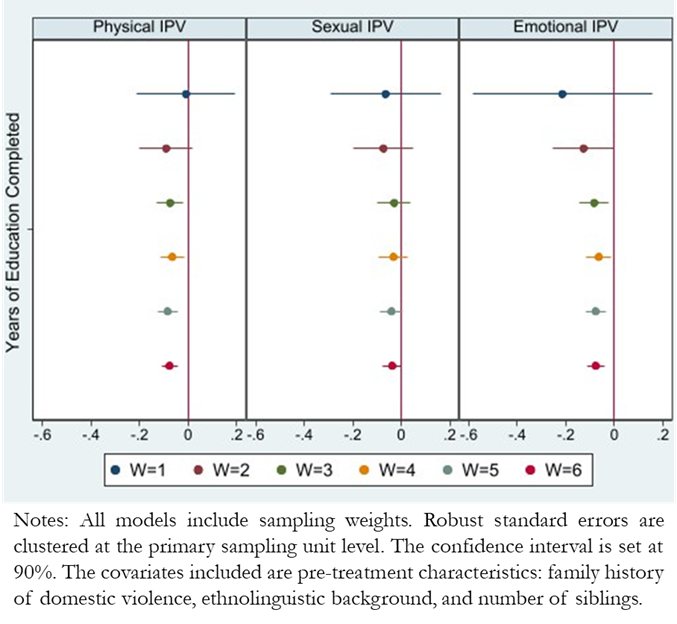by Elisabetta Calabresi[*]
The analysis investigates the effect of female education on the prevalence of Intimate Partner Violence (IPV) in Uganda and the channels underlying this effect. I adopt a local randomization approach to a fuzzy Regression Discontinuity Design, exploiting the implementation of the Universal Primary Education policy in 1997. An additional year of schooling decreases the physical IPV index by 7.4 percentage points and the emotional IPV index by 8.3 percentage points on average, for complier ever-in-union women born between 1981 and 1986. The main mechanism behind the impact seems to be assortative matching, while there are no effects on women’s gender attitudes, labor market outcomes, and relationship characteristics. The results are consistent with various robustness checks, and further suggest that the relationship between female education and IPV is context-dependent and that female education may help, but it is not sufficient, for achieving real gender equality.
Motivation
Intimate Partner Violence (IPV) is a social, health, and human rights problem that dramatically affects the lives of billions of people all around the world. The majority of victims are women: globally, almost 1/3 of women aged 15-49 years have experienced some form of violence by the partner or ex-partner (WHO, 2021; Sardinha et al., 2022). IPV has serious adverse consequences on physical, mental, sexual, and reproductive health, and on labor market outcomes. Moreover, it has severe negative externalities on children (Erten, 2022). Economically speaking, these consequences translate into an estimated global cost of IPV of around 5.2% of the global GDP (Fearon & Hoeffler, 2014).
Female empowerment has been often considered a major tool in the fight against domestic violence, but its impact is actually ambiguous. Indeed, on the one hand, female economic empowerment may reduce IPV risk by increasing women’s outside options and bargaining status, and by reducing their exposure to perpetrators and the household’s financial stress. On the other hand, female empowerment may increase this risk because violence may be used as an instrument for extracting resources and as a backlash for asserting dominance in the household. There is a growing literature investigating the IPV effects of policies fostering various aspects of female empowerment, such as unilateral divorce legalization, prosecution policies, cash transfers, and labor market opportunities, but the findings are mostly mixed (Erten, 2022).
However, there is a dimension of female empowerment that has not received the deserved attention in this literature: female education. Indeed, several analyses have observed a negative association between female education and IPV, but this may be biased by unobservable and unobserved characteristics affecting both the level of female schooling attainment and the prevalence of IPV. The importance of identifying the causal impact derives from the current international emphasis on promoting female education (UN General Assembly, 2015) and from the remark that its relationship with IPV is not straightforward (Erten & Keskin, 2018). Indeed, the effect may move through several channels. Firstly, female education may change women’s attitudes towards domestic violence, making them more conscious of its forms and less tolerant of it. Secondly, it may improve women’s labor market outcomes, with the above-mentioned ambiguous effects on IPV. Moreover, female education may lead to assortative matching, so that more educated women may choose or end up with “higher quality” partners: partners with characteristics that decrease their likelihood of exerting violence. Finally, female education may affect some relevant relationship characteristics. These channels are interconnected and may be at play more than one at a time. Erten and Keskin (2018) found that the rise in female education in Turkey increased psychological and economic IPV through the mechanism of labor market outcomes.
My research aims at identifying the impact of an increase in female schooling attainment on the prevalence of IPV in Uganda, one of the countries with the highest IPV pervasiveness around the world (more than half of ever-in-union women affected in 2016). Therefore, I contribute to the connection between the literature investigating the effects of female education and the literature studying the policies that may reduce IPV. Moreover, with respect to the paper by Erten and Keskin (2018), I use a different methodological approach and examine a different context, so that the final impact and the mechanisms at play may diverge, as in fact happens.
Data and empirical strategy
Identifying the causal effect of female education on IPV prevalence is not immediate, since both may be affected by some elements on which I do not have information, such as childhood’s socioeconomic status, upbringing, and gender discriminating norms. In order to address this endogeneity, I adopt a so-called local randomization approach to a fuzzy Regression Discontinuity Design (Cattaneo et al., 2018), exploiting the Universal Primary Education (UPE) policy as a natural experiment. The UPE reform abolished school fees at all levels of primary school starting from the 1st of January 1997. Considering that the Ugandan educational system consists of 7 years of primary school with the school starting age of 6, the policy should have affected children born in 1984 or later (children of primary school ages or younger at the time of its implementation). Therefore, I consider the UPE reform (the “treatment assignment”) as a plausibly exogenous change in female education (the “treatment take-up”) in a small window of cohorts around the year of birth 1984 (the “cutoff”). So, girls born just above and just below 1984 are considered comparable in both observable and unobservable characteristics. The idea is that being of primary school age at the time of UPE implementation can be considered an as-good-as random condition in the selected window. Moreover, it is assumed that, in that window, the year of birth and the exposure to the policy affect the IPV prevalence only through women’s schooling attainment: namely, that the exclusion restriction holds. The setting is said “fuzzy” because not all the girls exposed to the policy increased their education, especially considering the spread of school delayed entries and early drop-outs in Uganda.
The relevant window for estimation is set at 3 years: women born between 1981 and 1983 are considered as not exposed to UPE, while those born between 1984 and 1985 are considered as exposed. This length is the largest possible for which the UPE exposure and the educational attainment do not affect the probability that the women have ever had a relationship. In this way, I avoid possible selection into the sample of ever-in-union women, which is the group for whom the outcome of interest is defined. Moreover, predetermined characteristics (family history of domestic violence, ethnolinguistic background, and the number of siblings) are well-balanced between the two considered groups. Finally, the length of 3 years is also used in other papers adopting the same strategy to study UPE effects on various outcomes (Behrman, 2015a; Behrman, 2015b; Behrman et al., 2017).
Therefore, I estimate a Two-Stage Least-Squares model in the window of 3 years around 1984. The data for the analysis comes from the Ugandan Demographic and Health Survey of 2016. Questions about IPV were asked, confidentially, to women between 15 and 49 years old that have had at least one relationship. The outcome of the analysis is represented by three indices for physical, sexual, and emotional violence.
Findings and robustness checks
In the selected window, women exposed to the UPE policy have on average 1.39 years more of schooling with respect to women who were older than official primary school ages in 1997. This is the first stage of the analysis, and it appears to be strong enough, having an F statistic of 24.43 (Staiger & Stock, 1994). Moreover, the reform was successful in increasing the likelihood that women complete both primary and secondary school, and that they are literate.
Looking at the relationship between female education and IPV, the Ordinary Least Squares (OLS) results reveal a negative and significant association between women’s educational attainment and physical and emotional violence. However, these findings are likely to be biased, as already specified, so I look at the Reduced Form (RF) and Two-Stage Least-Squares (2SLS)models. The RF regressions investigate the effect of having been exposed to UPE on IPV prevalence. The reform has negative and significant effects on ever having suffered from physical and emotional violence by the partner. Finally, the 2SLS regressions identify the Local Average Treatment Effect of female education on IPV prevalence for ever-in-union women in the window of 3 years. An additional year of schooling reduces the physical violence index by 7.4 percentage points (corresponding to 0.105 standard deviations) and the emotional violence index by 8.3 percentage points (corresponding to 0.103 standard deviations).
The validity of the empirical strategy and the robustness of the results are confirmed by a series of checks, using for instance different indices for IPV and for the exposure to UPE. Additionally, the results are not too sensitive to the selection of the window (see Figure 1): the effect on sexual violence is never significant, that on physical violence is always negative and significant from the window of 3 years onwards, and that on emotional violence is always negative and significant also in the window of 2 years around the cutoff.
Figure 1: Results’ sensitivity to window selection

However, one may argue that the findings are exclusively due to the age difference between the groups exposed or not exposed to the UPE policy, since this difference in age is reflected in a difference in exposure to the risk of IPV. In particular, the group not exposed to UPE may have suffered more IPV over its life simply because it is older. This threat is largely reduced considering a small window of birth cohorts, but I also explored the effect of female education on the IPV prevalence in the 12 months preceding the survey. The direction of the effect is the same as the main analysis, but it is statistically different from 0 only for the emotional violence index. Another possible threat to the exclusion restriction is that the reform might have affected also the education of the women’s partners, which in turn may affect IPV prevalence. However, there is evidence that the policy did not influence males’ years of schooling (Behrman, 2015a; Keats, 2018). Moreover, since the average age difference between partners in Uganda is of 6 years, and this is not affected by the treatment, on average the partners of women in the selected window were not of primary school ages in 1997. For the avoidance of doubt, the findings are consistent also restricting the sample to women whose partner is at least 3 years older.
Potential mechanisms and interpretation
The analysis shows that an increase in girls’ years of schooling in Uganda negatively affected the emotional and physical IPV prevalence. But what may be the relevant channel behind these effects? As mentioned, there are mainly four potential mechanisms: changes in gender attitudes, labor market outcomes, partner’s and/or relationship’s characteristics (Erten & Keskin, 2018).
The attitudes channel is investigated by analyzing the effect of an increase in educational attainment on the respondent’s justification of wife-beating in various scenarios and of negotiations of sexual relationships. The relevance of this channel lies in the extent to which education may make women less tolerant of violence and/or more aware of its shapes, potentially reducing their risk of experiencing IPV (especially if combined with effective outside options). However, in the current context, female schooling did not affect gender and domestic violence attitudes. This result actually reduces concerns about another possible threat to the analysis: namely, that the increase in education changed the reporting rate of IPV.
Secondly, female education may affect IPV by modifying women’s labor market outcomes. Indeed, better labor market outcomes provide women with more outside options and bargaining power within the household, decreasing IPV. However, women’s labor outcomes may also increase their risk of experiencing violence as an instrument for extracting resources and/or as backlash because of possibly contrasting gender norms. In this analysis, increased years of schooling only reduced the likelihood that the woman works in the agricultural sector, not affecting the probability of being employed, the type of earnings received, nor the assets’ ownership.
Moreover, female education may reduce the incidence of IPV also through the so-called assortative matching, so that more educated women have partners with characteristics that may make them less likely to perpetrate violence. Women’s additional grades attained reduce the age and schooling difference between the spouses, and increase the likelihood that the partner has completed secondary school, that he is employed, and that he works in sectors other than the agricultural one.
The last potential channel that I consider is that of changes in past and current relationship characteristics, which may be affected by the woman’s level of education and may alter her risk of suffering from IPV. However, it seems that female education did not affect various measures of bargaining power within the household nor the household’s type of residence, but it increases the probability that the household is in the highest wealth quintile.
Therefore, the IPV reduction seems to be mostly due to assortative matching: more educated women match with more educated and better-employed partners, ending up in richer households. The reason why these changes lead to a reduction in IPV can be reconnected to various theories. Indeed, the observed decline in IPV may be due to the minor financial stress in the household. Moreover, it may be ascribed to the partner’s better employment status, since this may reduce potential male backlash, instrumental use of violence, and the time the couple spends together. Additionally, the partner’s higher schooling attainment may have fostered more gender-equal attitudes. Finally, the IPV decrease may be due to the lower inequality between the spouses in terms of both educational attainment and employment sector (but this is not reflected in other measures of women’s empowerment within the household). In general, there is suggestive evidence that the negative effect of female education on emotional and physical IPV in Uganda is due to assortative matching, but it is not possible to identify which ones of the mentioned changes in the partners’ characteristics play the most significant role in reducing IPV. Moreover, it should be noted that this channel, differently from the others, does not assure that female education contributes to an overall reduction of IPV, since the phenomenon may be more heavily suffered by less educated women who possibly match with “lower-quality” partners in terms of features more likely conducive of violence.
The last point that is worth discussing is the null effect of female education on sexual IPV. Given that the main mechanism behind the decline in physical and emotional IPV appears to be assortative matching, this result implies that changes in the above-mentioned partners’ characteristics do not affect the incidence of sexual violence in the current context. More specifically, it seems that the household’s wealth, the partners’ employment status and educational level, and the couples’ inequality in terms of schooling attainment and employment sector, are not relevant elements in determining the prevalence of this specific kind of IPV in Uganda. This consideration suggests that further research is needed in order to tackle sexual IPV.
Conclusions
To sum up, using a local randomization approach to a fuzzy Regression Discontinuity Design, the analysis finds evidence that female education decreases emotional and physical IPV, for complier ever-in-union women born between 1981 and 1986 in Uganda. The effect on emotional IPV is strongly consistent with all the performed robustness checks, and that on physical IPV is mostly consistent. The results may seem in contrast with those by Erten & Keskin (2018), but the analyses actually provide evidence of two different channels through which the effect may move. The authors found that, in Turkey, female education improved women’s labor market outcomes, resulting in higher IPV because of instrumental violence and/or male backlash. I, instead, provide evidence of the assortative matching channel, which adversely affects the IPV prevalence.
In general, the study shows that female education may help in reducing IPV, providing further incentives to governments to promote this dimension of female empowerment. However, it also emphasizes that increasing women’s education alone is not sufficient for achieving a more comprehensive concept of female empowerment, as expected. Indeed, the rise in female education in Uganda did not have a strong impact on women’s gender attitudes, labor market outcomes or empowerment within the household. Additionally, the contrasting results with the analysis by Erten & Kesin (2018) indicate that the relation between female education and IPV prevalence is context-dependent. Therefore, policy-makers should accurately study and take into account the constraints that, in any given context, may impede that higher female education translates into improvements in women’s well-being both within the household and in the labor market. Moreover, the analysis suggests the importance of designing policies on the side of the perpetrators in order to reduce the IPV prevalence. Finally, the study indicates that researchers and policy-makers should consider in detail the various kind of IPV, in order to grasp the causes behind any specific act of violence and adequately tackle them.
References
Behrman, J. A. (2015a). Does schooling affect women’s desired fertility? Evidence from Malawi, Uganda, and Ethiopia. Demography, 52(3), 787-809.
Behrman, J. A. (2015b). The effect of increased primary schooling on adult women's HIV status in Malawi and Uganda: Universal Primary Education as a natural experiment. Social science & medicine, 127, 108-115.
Behrman, J. A., Peterman, A., & Palermo, T. (2017). Does keeping adolescent girls in school protect against sexual violence? Quasi-experimental evidence from east and southern Africa. Journal of Adolescent Health, 60(2), 184-190.
Cattaneo, M. D., Idrobo, N., & Titiunik, R. (2018). A practical introduction to regression discontinuity designs: Volume II. Monograph prepared for Cambridge Elements: Quantitative and Computational Methods for Social Science. Cambridge University Press.
Erten, B., & Keskin, P. (2018). For better or for worse?: Education and the prevalence of domestic violence in Turkey. American Economic Journal: Applied Economics, 10(1), 64-105.
Erten, B. (2022). The Causes and Consequences of Domestic Violence [PowerPoint slides], May 11, 2022. https://drive.google.com/file/d/1j_6JGgJmEgxMJZDffTFQ7j11HvdEs2t_/view
Fearon, J., & Hoeffler, A. (2014). Benefits and costs of the conflict and violence targets for the post-2015 development agenda. Conflict and violence assessment paper, Copenhagen Consensus Center, 1-65.
Keats, A. (2018). Women's schooling, fertility, and child health outcomes: Evidence from Uganda's free primary education program. Journal of Development Economics, 135, 142-159.
Sardinha, L., Maheu-Giroux, M., Stöckl, H., Meyer, S. R., & García-Moreno, C. (2022). Global, regional, and national prevalence estimates of physical or sexual, or both, intimate partner violence against women in 2018. The Lancet, 399(10327), 803-813.
Staiger, D. O., & Stock, J. H. (1994). Instrumental variables regression with weak instruments. Econometrica, 65, 557—586.
UN General Assembly (2015). Transforming our world: the 2030 Agenda for Sustainable Development, 21 October 2015, A/RES/70/1.
World Health Organization. (2021). Violence against women prevalence estimates, 2018: global, regional and national prevalence estimates for intimate partner violence against women and global and regional prevalence estimates for non-partner sexual violence against women. https://apps.who.int/iris/handle/10665/341337.
[*] Ph.D. student in Development Economics, University of Florence.









